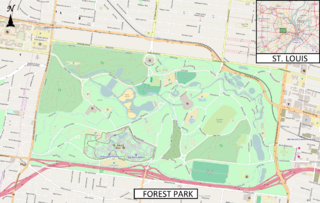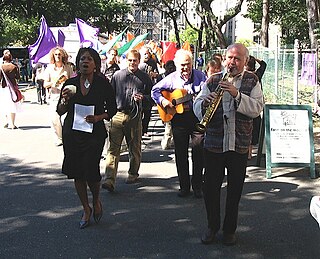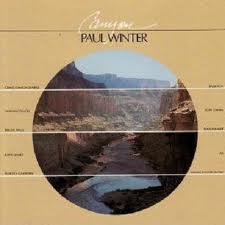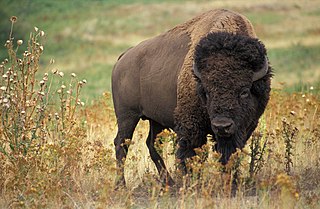
The Saint Louis Zoological Park, commonly known as the Saint Louis Zoo, is in Forest Park in St. Louis, Missouri. It is recognized as a leading zoo in animal management, research, conservation, and education. The zoo is accredited by the Association of Zoos and Aquariums (AZA). Admission is free based on a public subsidy from a cultural tax district, the Metropolitan Zoological Park and Museum District (ZMD); fees are charged for some special attractions. A special feature is the 2 ft narrow gauge Emerson Zooline Railroad with passenger trains pulled by Chance Rides C.P. Huntington locomotives that encircle the zoo, stopping at the more popular attractions.

Banff National Park is Canada's oldest national park and was established in 1885. Located in the Rocky Mountains, 110–180 kilometres (68–112 mi) west of Calgary in the province of Alberta, Banff encompasses 6,641 square kilometres (2,564 sq mi) of mountainous terrain, with many glaciers and ice fields, dense coniferous forest, and alpine landscapes. The Icefields Parkway extends from Lake Louise, connecting to Jasper National Park in the north. Provincial forests and Yoho National Park are neighbours to the west, while Kootenay National Park is located to the south and Kananaskis Country to the southeast. The main commercial centre of the park is the town of Banff, in the Bow River valley.

The Paul Winter Consort is an American musical group, led by soprano saxophonist Paul Winter. Founded in 1967, the group mixes elements of jazz, classical music, world music, and the sounds of animals and nature. They are often classified as "new age" or "ecological jazz", and their musical style is often called "Earth Music". The group has had many lineup changes since it was founded. Long-standing members currently in the group include Paul Winter, cellist Eugene Friesen, bassist Eliot Wadiopan, jazz oboist Paul McCandless, and percussionist and frame drum specialist Glen Velez. Past members who were part of the group for a considerable length of time include Paul Halley, Susan Osborn, Oscar Castro-Neves, Russ Landau, David Darling, Jim Scott, Dorothy Papadakos, and Rhonda Larson.

William A. Switzer Provincial Park is a provincial park in Alberta, Canada.

Christopher "Chris" Taylor is an American multi-instrumentalist and record producer. He is best known as the bass guitarist, backing vocalist and producer of the Brooklyn-based indie rock band Grizzly Bear, with whom he has recorded four studio albums. Taylor also records solo material under the moniker CANT, releasing his debut album, Dreams Come True, in 2011.

When Yellowstone National Park was created in 1872, gray wolf populations were already in decline in Montana, Wyoming and Idaho. The creation of the national park did not provide protection for wolves or other predators, and government predator control programs in the first decades of the 1900s essentially helped eliminate the gray wolf from Yellowstone. The last wolves were killed in Yellowstone in 1926. After that time, sporadic reports of wolves still occurred, but scientists confirmed that sustainable wolf populations had been extirpated and were absent from Yellowstone during the mid-1900s.

The Alberta Mountain forests are a temperate coniferous forests ecoregion of Canada.

The ecology of the Rocky Mountains is diverse due to the effects of a variety of environmental factors. The Rocky Mountains are the major mountain range in western North America, running from the far north of British Columbia in Canada to New Mexico in the southwestern United States, climbing from the Great Plains at or below 1,800 feet (550 m) to peaks of over 14,000 feet (4,300 m). Temperature and rainfall varies greatly also and thus the Rockies are home to a mixture of habitats including the alpine, subalpine and boreal habitats of the Northern Rocky Mountains in British Columbia and Alberta, the coniferous forests of Montana and Idaho, the wetlands and prairie where the Rockies meet the plains, a different mix of conifers on the Yellowstone Plateau in Wyoming and in the high Rockies of Colorado and New Mexico, and finally the alpine tundra of the highest elevations.

Missa Gaia/Earth Mass is an album released by Paul Winter in 1982 for Living Music. He co-wrote the mass with Paul Halley, Jim Scott, Oscar Castro-Neves, and Kim Oler. The title stems from two languages, Latin and Greek. The Earth Mass was one of the first contributions made by Paul Winter when he and his Paul Winter Consort became the artists in residence at the Cathedral of St. John the Divine in New York City. The mass includes the usual text, such as the Kyrie and the Agnus Dei, and also other text, hymns, and instrumental pieces. The mass is an environmental liturgy of contemporary music. It features the instrumentation of the Paul Winter Consort along with a choir, vocal soloists, and the calls of wolves, whales, and many other animals that are woven into the pieces, sometimes used as the melody.

Canyon is an album released in 1985 by Paul Winter, featuring his Paul Winter Consort. It was recorded in a small side canyon located in the Grand Canyon, which the members of the Consort nicknamed Bach's canyon, due to its 7-second reverberation, which made a perfect place to record music. The original idea of playing music in the canyon began when Winter played his saxophone while standing on the edge of the canyon, and felt that the long echoes coming back from the canyon almost seemed like the Earth was responding back to him.

Wintersong is an album released in 1986 by Paul Winter, featuring the Paul Winter Consort. The album is a collection of lesser known folk melodies from North America and Europe, arranged in a mixed style of jazz and classical, and played with Brazilian rhythms.

Earth: Voices of a Planet is an album released by Paul Winter in 1990. The album was a commissioned for the 20th anniversary of Earth Day, and was premiered in Times Square by the Paul Winter Consort and special guests. The album is a tribute to the Earth, and features at least one instrument or voice from every continent. The album also features animal calls woven into the music. In particular, recordings of elephant basso-rumbles are used. These sounds, created by elephants, are too low for the human ear to detect on its own, and their existence was unknown until shortly before the album was created.

Solstice Live! is a live album released by Paul Winter in 1993. The album is a recording of a performance of Paul Winter's annual Winter Solstice Celebration, which takes place in the Cathedral of St. John the Divine in New York City. The concert is a contemporary celebration of the longest night of the year, and the return of the sun. It features contemporary symbols for various parts of the celebration created by Winter. These symbols are both an artistic visual representation of something as well as a musical instrument played on during the performance. These symbols include the Sun Gong, a giant gong that is hit with yellow and red light, and risen 100 feet to the top of the cathedral ceiling, along with its player. Another is the Solstice Tree, a large sculpture of an evergreen tree, upon which is hung various cymbals, bells, chimes and gongs. The performance always features the Paul Winter Consort, and special guest musicians that Paul Winter has met or collaborated with, making it a celebration of the world's people and their music.

Crestone is an album by Paul Winter Consort, released in 2007 through the record label Living Music. The album is named after the community of Crestone, Colorado. The album was recorded in the Sangre de Cristo Mountains, the Great Sand Dunes, and the San Luis Valley of southern Colorado, all of which are located near Crestone. In 2008, the album earned the group a Grammy Award for Best New Age Album.

Miho: Journey to the Mountain is an album by Paul Winter Consort, released in 2010 through the record label Living Music. The album was commissioned by the Miho Museum in Kyoto, Japan to be a musical celebration of the museum. The museum is a unique piece of architecture, built on the top of a mountain, and partially tunneling into it, giving the experience of the museum being part of the Earth. The album was recorded in the corridors of the museum, which are naturally reverberant. In 2011, the album earned the group a Grammy Award for Best New Age Album.
Spanish Angel is a live album by Paul Winter Consort, released in 1993 through the record label Living Music. In 1994, the album earned the group a Grammy Award for Best New Age Album.

The White Goat Wilderness Area is a provincially designated wilderness area in the Canadian Rockies of Alberta. It was established in 1961 and it, as one of the three wilderness areas of Alberta, has the strictest form of government protection available in Canada. All development is forbidden and only travel by foot is permitted. Hunting and fishing are not allowed. The other two wilderness areas are Ghost River Wilderness Area and Siffleur Wilderness Area and together the three areas total 249,548.80 acres (100,988.82 ha).

The Siffleur Wilderness Area is a provincially designated wilderness area in the Canadian Rockies of Alberta. It was established in 1961 and it, as one of the three wilderness areas of Alberta, has the strictest form of government protection available in Canada. All development is forbidden and only travel by foot is permitted. Hunting and fishing are not allowed. The other two wilderness areas are White Goat Wilderness Area and Ghost River Wilderness Area and together the three areas total 249,548.80 acres (100,988.82 ha).

























